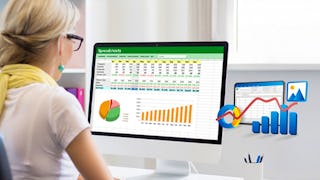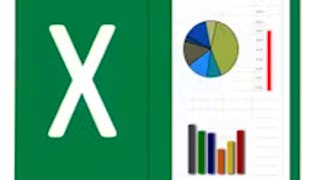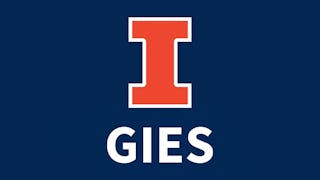A leader in a data driven world requires the knowledge of both data-related (statistical) methods and of appropriate models to use that data. This Business Analytics class focuses on the latter: it introduces students to analytical frameworks used for decision making though Excel modeling. These include Linear and Integer Optimization, Decision Analysis, and Risk modeling. For each methodology students are first exposed to the basic mechanics, and then apply the methodology to real-world business problems using Excel.

6 days left: Get a Black Friday boost with $160 off 10,000+ programs.Save now.


Business Analytics with Excel: Elementary to Advanced

Instructor: Joseph W. Cutrone, PhD
Top Instructor
552,197 already enrolled
Included with 
(3,999 reviews)
Recommended experience
Skills you'll gain
- Mathematical Modeling
- Analysis
- Risk Analysis
- Risk Modeling
- Business Process Modeling
- Transportation Operations
- Financial Analysis
- Microsoft Excel
- Statistical Methods
- Business Analytics
- Data Modeling
- Operations Research
- Resource Allocation
- Process Optimization
- Statistical Analysis
- Predictive Analytics
- Linear Algebra
- Complex Problem Solving
- Regression Analysis
- Business Modeling
Details to know

Add to your LinkedIn profile
23 assignments
See how employees at top companies are mastering in-demand skills

There are 6 modules in this course
The purpose of this course is to expose you to a variety of problems that can be solved using management science methods and modelled in Excel. In this course, we start from the basics of spreadsheet design and work our way up to broader mathematical optimization modelling. Many airlines, banks, and technology companies could not operate today as they do without the skills and techniques taught in this course. In this first module, we begin by introducing a relatively simple example of a mathematical model which we will use as our platform to build off of for more complicated applications later in the course. Many problems used in the video lectures come from the text Business Analytics: Data Analysis & Decision Making by Albright & Winston (Cengage Learning, 2014), ISBN 1285965523
What's included
3 videos6 readings1 assignment1 discussion prompt
We are now ready to introduce more complexity to our spreadsheet models. Since everyone comes from different Excel backgrounds, we will review some basic functions and features as well as more advanced techniques. This module covers more of the modelling process and includes some of the less-well known, but particularly helpful, Excel functions and tools that are available. Remember though that this course's objective is not to be a "how-to" of Excel. Instead, the focus and intent is to use these features to provide insights into real business problems.
What's included
2 videos5 readings4 assignments1 discussion prompt
In this module the modeling concept of estimating relationships between variables by curve fitting, or regression analysis, is used to solve realistic business problems. Different regression curves are introduced and a mathematical analysis of which curve is best to help defend the model is presented. This allows not only an understanding of the techniques of modelling but also the rational behind which model to use.
What's included
2 videos6 readings5 assignments1 discussion prompt
In this module we introduce spreadsheet optimization, one of the most powerful and flexible methods of quantitative analysis. The specific type of optimization presented here is linear programming (LP) which is used in all types of organizations to solve a wide variety of problems. As you will see through the examples presented in this course, LP is used in problems of labor scheduling, inventory management, advertising, finance, transportation, staffing, and many others. The goal of this module is to introduce you to the basic elements of LP, the types of problems it can solve, and how to model an LP problem in excel.
What's included
4 videos7 readings5 assignments1 discussion prompt
This module provides even more examples of problems that can be modeling using linear programming (LP), in particular Transportation and Assignment problems. The basic transportation problem is concerned with finding the best (usually the least cost) way to distribute the good from sources such as factories, to final destinations such as retail outlets. The assignment problem involves finding the best (usually the least cost) way to assign individuals or pieces of equipment to projects or jobs on a one-to-one basis. Using Solver, we will take advantage of the special structure of these LP problems to find the best solutions to complex business problems in an efficient way.
What's included
4 videos4 readings3 assignments1 discussion prompt
This module presents yet another subset of important mathematical linear programming models that arise when some of the basic assumptions of an LP model are made more or less restrictive. For example, restricting the decision variables to be whole numbers leads to the process of Integer Programming. Restricting the decision variables to be either 0 or 1 leads to binary programming. Lastly, we will see how the skills in this course can be used to solve more complex problems that involve nonlinear models.
What's included
5 videos11 readings5 assignments
Instructor

Offered by
Explore more from Business Essentials
 Status: Free Trial
Status: Free TrialSimplilearn
 Status: Preview
Status: PreviewJohns Hopkins University
 Status: Free Trial
Status: Free Trial Status: Free Trial
Status: Free TrialUniversity of Illinois Urbana-Champaign
Why people choose Coursera for their career




Learner reviews
3,999 reviews
- 5 stars
81.12%
- 4 stars
15.89%
- 3 stars
1.72%
- 2 stars
0.34%
- 1 star
0.89%
Showing 3 of 3999
Reviewed on Jul 15, 2024
Reviewed on Apr 6, 2024
Amazing course to support business decisions through statistics and data validation. Includes almost all the essential skills required to run and understand a business. Loved it.
Reviewed on Jul 23, 2024
Good course to follow if you are interested in expand your knowledge in excel data analysis, especially focusing on business analytics. Lectures and resource materials are very clear and helpful.

Open new doors with Coursera Plus
Unlimited access to 10,000+ world-class courses, hands-on projects, and job-ready certificate programs - all included in your subscription
Advance your career with an online degree
Earn a degree from world-class universities - 100% online
Join over 3,400 global companies that choose Coursera for Business
Upskill your employees to excel in the digital economy
Frequently asked questions
To access the course materials, assignments and to earn a Certificate, you will need to purchase the Certificate experience when you enroll in a course. You can try a Free Trial instead, or apply for Financial Aid. The course may offer 'Full Course, No Certificate' instead. This option lets you see all course materials, submit required assessments, and get a final grade. This also means that you will not be able to purchase a Certificate experience.
When you purchase a Certificate you get access to all course materials, including graded assignments. Upon completing the course, your electronic Certificate will be added to your Accomplishments page - from there, you can print your Certificate or add it to your LinkedIn profile.
Yes. In select learning programs, you can apply for financial aid or a scholarship if you can’t afford the enrollment fee. If fin aid or scholarship is available for your learning program selection, you’ll find a link to apply on the description page.
More questions
Financial aid available,

